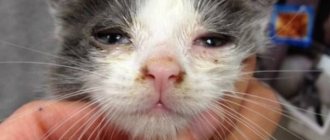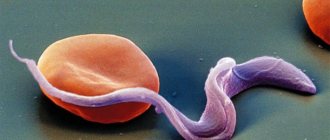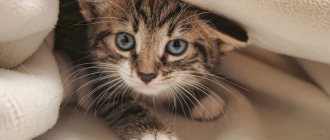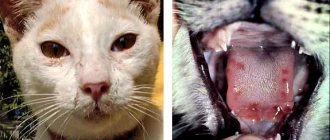Infectious rhinotracheitis in cats (feline herpes) is a dangerous disease of viral origin that affects the eyes and respiratory system. The virus affects cats of all age groups. Cats living in close proximity to infected pets, especially in kennels or shelters, are at greatest risk of contracting the virus.
Feline viral rhinotracheitis is caused by feline herpesvirus 1 (FHV-1) of the Herpesviridae family. It is also called "cat flu" or "feline pneumonia". Rhinotracheitis is not dangerous for humans; our diseases are caused by other viruses of the same family.
Epizootological data
Viral respiratory infections in cats are quite common. Both adults and small kittens with weakened immune systems are affected. The source of rhinotracheitis are infected cats and virus carriers. If a pregnant cat is not vaccinated, this can lead to intrauterine infection of the kittens. Recovered animals will be latent carriers of the herpes virus.
The infection most often affects young animals and weakened older animals. If the immune system copes with the infection, after 8-10 days the disease enters the latent phase: there is no discharge, the animal is outwardly healthy, but the virus lies dormant in its body and if the immune system is weakened, it can appear again.
Rhinotracheitis itself is not very dangerous, but if the animal is weakened, the damaged mucous membranes are attacked by bacteria and protozoa - mycoplasma and chlamydia, and this is what can lead to the pet’s blindness or even death. Such outcomes usually occur in very young kittens.
Vaccination will protect your pet if he has not yet had contact with the virus, and if he has already had contact with the virus, then vaccination will protect him from severe disease. The first vaccination is done in the first months of life (8-10 weeks), after 2 weeks it is repeated, then done after a year and revaccinated once every 2-3 years. This vaccination is carried out in combination with vaccinations against calicivirus and the most dangerous disease of cats - panleukopenia.
Causes of rhinotracheitis
global $ads_google; //data-ad-slot=”2475549904″ $ads_google = empty($ads_google) ? false : true; ?> if ($ads_google == false) {?>
$ads_google = true; ?> } ?>
Feline rhinotracheitis is transmitted mainly from sick or recovered animals through airborne droplets. Also, the infection can be brought home by a person on his clothes or hands after petting someone else’s cat carrying the herpes virus. At high humidity, the virus remains viable for several days and quietly awaits its time in the outdoor environment, including soil, grass, and puddles. On the street, when cats come into contact with each other, infection can also occur: the virus is transmitted through the excretory, respiratory and visual organs.
If your pet has caught rhinotracheitis, then first of all you should know what this serious disease threatens.
How the virus is transmitted
Feline rhinotracheitis, also known as feline herpes virus, is easily transmitted to other cats if they come into contact with infected animals or share objects with them: bedding, bowls, toys. The virus is transmitted through secretions from the eyes, nose and trachea. Animals that have had contact with the virus are dangerous to others only during periods of exacerbation of the disease, when there are symptoms.
Although mild forms of feline rhinotracheitis go away on their own, seeing a veterinarian if you notice signs of this disease is necessary: firstly, it may be another disease that can be started, and secondly, the animal may require maintenance therapy or antibiotics.
What is viral rhinotracheitis
Respiratory disease in domestic and wild cats is caused by the feline herpes virus (Herpesvirus Type-1). The particle of the pathogen is called a virion and is a liquid capsule containing genomic DNA. On the outside, it is surrounded and protected by a protein shell. Above it is a lipid bilayer containing glycoproteins. In the cat’s body, viral particles begin to double and damage the mucous membranes of the eyes and upper respiratory tract. Inflammation of the sinuses, redness and swelling of the pharynx in sick kittens gave the name to the disease, registered in 1957 - Feline Viral Rhinotraccheitis (FVR). When a pet is infected, rhinotracheitis pathogen cells spread along the sensory nerves and reach the neurons. Here the virus stores its genomic DNA throughout the animal's life.
The causative agent of rhinotracheitis infects all cats
Feline rhinotracheitis is dangerous due to complications in individuals with weakened immune systems or other chronic diseases. In this case, the high activity of the virus causes tissue necrosis of the bronchi, digestive tract, nictitating membrane and cornea of the eyes. Inflammation is accompanied by a secondary infection caused by bacteria. The animal may go blind. If the nasal bone is destroyed or pulmonary edema develops, your pet will die.
The feline herpes virus strain exclusively affects cats. The owner of a pet with rhinotracheitis should not be afraid of infection. The disease is not transmitted to humans or other pets.
Cold and damp weather contributes to the spread of feline rhinotracheitis, because the virus is active only in a humid environment and dies immediately after drying out. At a temperature of +4°C, the pathogen is dangerous for more than five months, and when heated to +57°C, it is neutralized after 20 minutes. Virus particles that come into contact with the skin of a person’s hands are active for half an hour. Getting on toys, beds, food dishes, feline herpes serves as a source of infection for 8 hours. Home furniture becomes virus-free within 24 hours.
Outbreaks of rhinotracheitis occur at any time of the year with the appearance of a source of infection. Feral and abandoned cats living in cities migrate in search of food. In shelters for homeless animals, half of the pets get sick from one carrier. When kept in groups in nurseries, all individuals can get sick if the cats are in free contact with each other. The virus affects cats of all ages, but young animals and kittens are more often affected.
After suffering rhinotracheitis, the recovered pet becomes a latent carrier of the disease. Damaged mucous membranes of the respiratory tract are restored from the third week of illness. This occurs due to the animal’s immune system producing protective antibodies to virus particles.
Recurrence of symptoms of feline herpes is provoked by:
- weakened immunity due to a stressful situation;
- treatment with glucocorticoids;
- infection with other diseases;
- lactation.
In the chronic form of rhinotracheitis, the activity of the virus in the body of the sick animal does not stop. The reason is an insufficient amount of antibodies, inhibition of protective mechanisms. The pet constantly releases pathogenic particles into the environment and poses a risk of infection for healthy animals.
Symptoms of rhinotracheitis
The active phase of the disease is indicated by the following symptoms:
- frequent sneezing;
- discharge from the nose and eyes;
- salivation;
- lethargy;
- weight loss;
- the eyes are constantly partially blocked by the third eyelid;
- inflammation of the conjunctiva of the eyes (conjunctivitis);
- keratitis (inflammation of the cornea causing blurred vision);
- decreased appetite;
- general malaise;
- loss of pregnancy.
The temperature during rhinotracheitis does not rise above 38.3-38.5 ° C - for cats it is like 37 ° C for us. If there is a fever, we are not talking about rhinotracheitis or not only about it. In this case, you need to see a doctor as quickly as possible.
When treating sick pets, your veterinarian will evaluate clinical signs and the presence of secondary infections, and prescribe medications to speed recovery and keep your pet alive.
Diagnosis of rhinotracheitis
Diagnosis of rhinotracheitis is not difficult. You just need to do swabs and carry out PCR diagnostics. But similar symptoms are caused by several other infectious diseases: calicivirosis, mycoplasmosis, chlamydia. It is impossible to suspect which of them caused discharge from the nose and eyes of a particular cat. Of course, calicivirus has other symptoms, but in mild cases they may not appear.
There is a specific treatment against chlamydia and mycoplasmosis, without which these diseases will not go away. Therefore, it is necessary to find out exactly what exactly your pet is sick with. To do this, they either take a PCR test for each of these infections separately, or a so-called “respiratory profile”: such a comprehensive analysis is offered by an increasing number of laboratories.
Carrying out the analysis makes sense only in the acute phase of the disease. What needs to be taken for analysis is not the discharge, but the epithelium of the mucous membrane, so the doctor first carefully removes the crusts with saline solution, and then runs a cotton swab across the conjunctiva. Flushes are taken from both eyes and from the nasal passages.
Acute tracheitis. Symptoms
When viruses invade the cells of the tracheal mucosa, a local reaction develops, which leads to clinical manifestations such as:
- cough,
- excess mucus production
- sputum formation.
General symptoms in the form of intoxication of varying severity may also be observed2:
- weakness,
- increase in body temperature,
- pain in muscles and joints,
- headache.
Cough is a complex reflex reaction that is aimed at protecting the bronchopulmonary system5. On the one hand, cough prevents unwanted particles and substances from entering the bronchi; on the other hand, it promotes the removal of tracheobronchial secretions (sputum).
With tracheitis, the cough can be obsessive, frequent, and debilitating. Attacks become more frequent at night and may be accompanied by pain, a feeling of scratching or rawness behind the sternum and in the larynx5. Respiratory failure, as a rule, is not observed5.
At the beginning of the disease, the cough is dry and unproductive5. Once sputum production is activated, it becomes moist, which usually leads to improvement in the patient's condition5.
The voice with tracheitis is usually dull and hoarse5. A change in voice occurs due to the involvement of the larynx in the inflammatory process and traumatization of the vocal folds by a powerful air wave during coughing5. Frequent, paroxysmal and dry coughs are more damaging to the larynx5.
Up to contents
Treatment of rhinotracheitis in cats
In mild cases of rhinotracheitis, treatment is not required; care is sufficient: cleaning the nose and eyes from crusts using a cotton pad soaked in saline solution. If the animal has a decreased appetite, more nutritious diets are selected, temporarily switched to canned food or pates, and the principle of fractional feeding is applied. Monitoring the pet’s condition is extremely important: if it gets worse, it is necessary to add medications.
It can be:
- antibiotics – if a secondary infection occurs or tests reveal concomitant infections;
- interferon - in a recurrent form, it is advisable to apply it topically (by instilling into the eyes and nose) 4-6 times a day at the very beginning of the disease, before it has time to develop;
- human drugs for the treatment of herpesvirus – for severe systemic lesions;
- in the absence of appetite - infusion (droppers) intravenously or subcutaneously. The last method is sufficient in most cases.
- vitamin preparations, especially ascorbic acid, help the animal’s body form a sufficient immune response;
- If you have a painful cough, humidifying the air will help, for example, pour hot water into the bath, wait until the room is saturated with steam, bring your pet there and stand for 10-15 minutes.
Learn more about the symptoms, diagnosis, treatment and prevention of infectious rhinotracheitis in animals.
Prevention of rhinotracheitis
The most effective protection against viral rhinotracheitis is vaccination. The vaccine can be administered to a kitten starting at 8 weeks. Then, after 2 - 4 weeks, revaccination is done, which is then repeated once a year. Protection against rhinotracheitis is part of complex preparations for vaccinations: Nobivak Triket, Quadricat GKPB; Leukorifelinn, Purvax, Multifel-4.
If the cat has already had rhinotracheitis, it is necessary to disinfect the room and all objects that the animal has come into contact with. It is better to treat with bleach or caustic soda. The bactericidal agent must be kept for about 30 minutes, since this virus is highly resistant.
It is necessary to take care of strengthening the animal’s immunity. It is useful to give preventive immunomodulators, feed the cat properly and protect it from stress.
It is important to exclude any contact between your pet and stray cats. Street animals often become a source of infection. It must be remembered that rhinotracheitis is very contagious and easily transmitted.
How not to harm a pet with rhinotracheitis
Human methods of treating runny nose and cough are completely unsuitable for animals. Although the owner’s hand sometimes reaches for vasoconstrictor drops, using them in this case is unacceptable: they dry out the nasal mucosa of pets and make it easier for them to be affected by additional infections.
You cannot treat a cough with drugs to thin sputum like ACC and Lazolvan: rhinotracheitis is a viral process, with which thick sputum simply does not form, but these drugs can facilitate the flow of liquefied mucus containing viruses from the trachea into the lungs. And then, instead of the relatively harmless rhinotracheitis, the veterinarian will have to deal with a much more formidable viral pneumonia, which threatens the death of the animal.
If your eyes are affected, you should absolutely not try to drip any drops! In this case, an examination by a veterinarian is simply necessary, since it is important to understand whether the cornea is too damaged. Most drops are very aggressive if they get inside the eyeball, and the animal can permanently lose vision.
Treatment at home
Treatment at home involves simple rules that the pet owner must adhere to. Let's look at them in detail.
Home treatment for an infected animal:
- drink plenty of fluids (liquid should be at room temperature);
- fortified and high-calorie food (food should be warm);
- provide your pet with a cozy and warm place in the house;
- do not lower the temperature to 39.5 degrees.
Remember! If a sick cat refuses to eat, try feeding it in any way. Fasting will weaken the animal and can lead to aggravation of the disease.
If the cat completely refuses food, droppers are needed.
Prevention
Because feline rhinotracheitis virus is contagious, pet owners should keep sick cats away from healthy pets. The cat should be kept warm and should be stopped from walking outdoors for a while. Dishes for water and food need to be washed and disinfected more often. This is necessary to prevent re-infection.
There is a vaccine to protect pets from infectious diseases, however, it only reduces the risk of complications. You also need to feed your pet well, ventilate the room often and protect the home from drafts and cold temperatures.
Consequences of the disease and incubation period
The incubation period - the time from infection to the appearance of the first symptoms - ranges from 3 to 12 days. The disease itself lasts 5-14 days. With a weakened immune system, advanced cases, or lack of proper treatment, the animal will develop complications. Rhinotracheitis is especially dangerous in kittens. It leads to severe damage to the eyeballs and often such animals require removal of an eye, or even both. Kittens severely affected by herpesvirus cannot always be saved. Therefore, for very small pets, a visit to the veterinarian is literally necessary “at the first sneeze.”
Rhinitis in cats affects the digestive system in 20% of cases. Diarrhea, constipation or vomiting may occur, which becomes chronic quite quickly, in which case the animal will require a lifelong diet.
How does infection occur?
Almost all kittens suffer from rhinotracheitis, no matter what age or breed they are. The morbidity rate is high, and the mortality rate reaches almost 20%. If an animal has been ill with this disease, then it develops a strong immunity and the disease does not manifest itself again. Her little kittens bear it the hardest.
Note! Viral rhinotracheitis can occur in all kittens. Moreover, if the pet is constantly in the house and does not go outside, this still does not provide a 100% guarantee that infection will not occur. But in these cases it does not happen so often.
Infection often occurs through airborne droplets. The following methods of infection are distinguished:
- through direct contact with an infected animal;
- using objects from an infected kitten - tray, food bowl;
- during mating with a sick animal;
- kittens often become infected through an infected cat;
- rhinotracheitis can be carried by insects that have previously been in contact with an infected kitten;
- infection can occur during cat shows. In these places there is a high probability of infection;
- Sometimes a viral pathogenic organism can be carried by the host on clothes or shoes.










